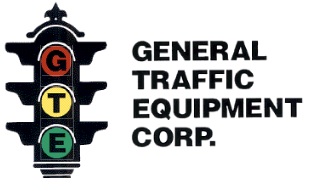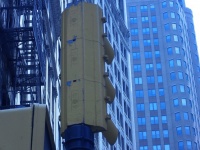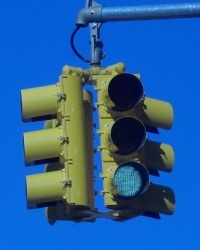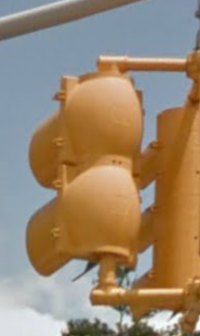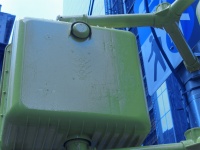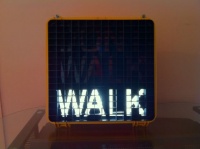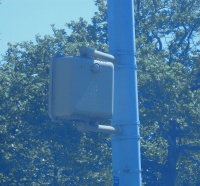General Traffic Equipment
Background
General Traffic Equipment (also commonly known as G.T.E.) is an American, family-owned signal equipment company that was established in 1978. Since then, the company has provided its own line of signals, equipment, and signal controllers to various states in the country. The company's president is Raymond G. Staffon. Originally, General Traffic Equipment's headquarters was based in Yonkers, New York; however, several years ago, the company relocated to the city of Newburgh in New York, in which is the current location. In general, all products of the company are manufactured on premises and are properly packaged and sent to the company's customers. One of the company's largest customers to date is the city of New York.
Vehicular Signals
Along the lines of vehicular signals, General Traffic Equipment has several models to choose from. Both aluminum and polycarbonate, not to mention, in regards to size, 8 and 12 inch. Most of what was manufactured could be viewed in service throughout the city of New York today, and many of these heads have been in service for over ten years. These are typically 8" vehicular signals, and two variations of this size are known to exist on the streets. The first version uses an aluminum housing that is practically identical to that of the model TE-19408 housing from Marbelite, in which was manufactured from the mid 1960s until the late 1970s. Incandescent signal indications were originally in use, and then L.E.D. signal indications appeared in later years. As of present day, General Traffic Equipment no longer manufactures this 8" model.
It was not until in recent years that the second kind of 8" head was introduced by the company, and its housing is also aluminum. Furthermore, the housing resembles that of an 8" Eagle Mark IV housing, in which the back appears round. General Traffic Equipment does not offer incandescent signal indications for this version, and tunnel visors are typically used for the head. Though cutaway and fully circular visors are considered as options. This traffic signal has spread throughout various locations in New York City within the past four years or so.
Aside from aluminum, the company also offers a polycarbonate version of the second generation of the 8" vehicular signal. One difference, though, to point out is that the aluminum version uses one latch for each door, while the polycarbonate version uses two latches for each door.
In continuation of several vehicular signal models offered by General Traffic Equipment, 12" heads are produced as well. A version made of aluminum and polycarbonate exist, and each kind is common to see in some states, like New Jersey and New York, for example. The back of the housing is round in appearance, and this appears similar to that of a 12" Eagle/Siemens vehicular signal.
To meet various municipalities' needs, General Traffic Equipment offers several different colors for its vehicular signals aside from the rather ordinary factory yellow, such as dark olive green, black, and gray. The company could also take special requests.
Pedestrian Signals
General Traffic Equipment's first line of pedestrian signals appeared sometime in the 1990s. At the time, the first model was the P-6. Made from polycarbonate, this model was composed of a 16" housing, in which encased a reflector assembly for illumination and a two-piece polycarbonate lens (available as "DONT WALK" and "WALK" and the hand and man). The door contained a louver, in which protected the two-piece lens behind it from mainly vandalism. This piece was fire retardant and had a box-grid design. In regards to the housing itself, the model P-6 had a rather unique characteristic, in which a small ventilation hole was located on the top portion of the back of the housing. Its purpose was simply to remove unwanted heat created by the illumination of the light bulbs inside, and a cap covered the ventilation hole, in which prevented debris and insects from entering the inside of the housing.
Because of General Traffic Equipment's significant involvement with the city of New York, the model P-6 pedestrian signal spread rapidly throughout New York City from the 1990s until the early 2000s. During this time period, D.O.T. of New York City typically installed it at a newly constructed signalized intersection, while it sometimes replaced an older pedestrian signal. Other times, it was part of an upgrade at an existing signalized intersection. In spite of the usage in the city of New York, the P-6 was also in use elsewhere outside of the city in New York state.
The model P-6 was compatible with L.E.D. inserts, and this was ideal for the time period of when alterations amongst pedestrian signals took place mainly in New York City, in which was from 2000 to 2005 or so. The conversion from "DONT WALK" and "WALK" to the hand and man was possible, and General Traffic Equipment once offered solely pedestrian signal housings for the installations, in which led to General Traffic Equipment's discontinuation of the option for the pedestrian signal to use incandescent signal indications sometime in the mid 2000s. The company would eventually discontinue production of the P-6 and introduce the second version of the model.
The second generation P-6 is practically identical to the first generation as far as design is concerned, but one minor difference to point out is that the second version has a modified ventilation hole on the back of the housing, and a large cap is no in use, since a smaller one is in use. Because incandescent signal indications are outdated, General Traffic Equipment does not offer the option to have the second generation P-6 available as either an incandescent "DONT WALK" and "WALK" or hand and man
